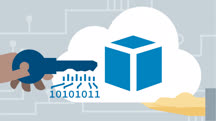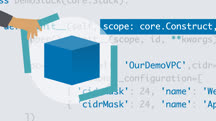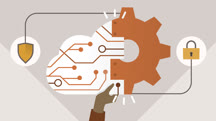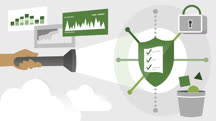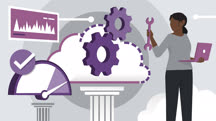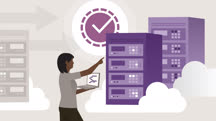Course catalog
Categories
Showing 961-980 of 8,871 items.
AWS for DevOps: Performance Optimization Best Practices
Get tips and tricks for optimizing performance as an AWS DevOps engineer. Learn how to measure performance and optimize network traffic, compute (EC2), and storage services.
AWS for DevOps: Security, Governance, and Validation
Learn best practices for security, governance, and validation. Explore topics in the third domain of the AWS Certified DevOps Engineer exam: Security, Governance, and Validation.
AWS Infrastructure as Code for Software Developers
Leverage your existing programming skills to deploy infrastructure. Explore a real-world architecture, and see how to write the code to deploy it using AWS CDK and Python.
AWS Machine Learning by Example
Take a deeper dive into machine learning with Amazon Web Services (AWS). Learn how to approach common machine learning tasks using key techniques.
AWS Quick Tips for Developers
Get bite-sized tips for working more efficiently with some of the most essential services in Amazon Web Services (AWS), the popular cloud platform.
AWS Security Best Practices for Developers
Create stronger, more secure applications for AWS deployment. Learn security best practices for Identity and Access Management, S3 storage, Key Management Service (KMS), and Cognito.
AWS Security Hub First Look (228001)
AWS Security Hub—a security dashboard and insights tool from Amazon—provides users with a one-stop dashboard from which they can monitor their deployment for common security issues, including vulnerable services and publicly available S3 buckets. Security Hub provides a convenient and flexible search tool to filter issue types, and identifies fixes that need to be applied to resources. Amazon is currently allowing users to take this powerful tool out for a spin as a preview. In this course, Scott Simpson provides a first look at Security Hub, helping to acquaint you with the tool before it officially joins the AWS suite. Learn about the main features of Security Hub, as well as how it can help you gain new insights and resolve security problems.
AWS Well-Architected Framework: Cost Optimization Pillar (230619)
The AWS Well-Architected Framework helps architects build secure, high-performing, resilient, and efficient infrastructures for their applications through five pillars. This course takes an in-depth look at the cost optimization pillar. Instructor Mark Wilkins reviews how to use cost optimization with the design properties of the cost optimization pillar, then goes into key financial management concepts. He explores budgeting and forecasting tools for cloud costs. He shows you how to monitor cost, usage, and the decommissioning of resources, then offers information on how to choose a pricing model. Mark goes over how to manage costs using the Billing and Cost Management dashboard. He also discusses the challenge of changing your design as new features and abilities are provided over time, then shows you how to match supply and demand. Plus, he provides a demo in which he uses the Well-Architected Tool to answer cost optimization pillar questions.
AWS Well-Architected Framework: Operational Excellence Pillar
Take a deeper look at the first pillar of the AWS Well-Architected Framework: operational excellence.
AWS Well-Architected Framework: Performance Efficiency Pillar (228375)
The AWS Well-Architected Framework includes strategies to help enterprise architects compare workloads against AWS-identified best practices. It is designed to help architects build secure, high-performing, resilient, and efficient infrastructure for their applications and comprises five pillars: operational excellence, security, reliability, performance efficiency, and cost optimization. In this course, Mark Wilkins takes an in-depth look at the fifth pillar, performance efficiency. Mark covers the different computing resources—including compute, storage, database, and network—and shows how to optimize performance for each. He also illustrates the importance of fine-tuning performance to maintain efficiency over time. This course is designed to work in conjunction with the remaining courses in the path, and while Mark covers some topics that were detailed in the other pillars, in this course he looks at these topics specifically from the viewpoint of efficiency.
AWS Well-Architected Framework: Reliability Pillar (228494)
The AWS Well-Architected Framework was designed to help architects build secure, high-performing, resilient, and efficient infrastructure for their applications. The framework is comprised of five pillars: operational excellence, security, reliability, performance efficiency, and cost optimization. In this course, designed as part of a six-part series covering the AWS Well-Architected Framework, take a deeper look at the third pillar: reliability. Discover the purpose and place of the reliability pillar, plus key AWS reliability services such as CloudWatch. Learn about designing reliable infrastructure with Availability Zones, load balancing (ELB), and DNS (Route 53). Along the way, review demonstrations of real-world challenges and see how to implement key services to prevent—and recover from—failures.
AWS Well-Architected Framework: Security Pillar
Take a deeper look at the second pillar of the AWS Well-Architected Framework: security.
AWS: Automation and Optimization
Learn strategies for optimizing, automating, and auto-scaling processes. Get some guidance around how to control costs while successfully managing cloud operations using AWS.
AWS: Controlling Cost (234461)
Learn how to use Amazon Web Services (AWS) tools and best practices to understand, forecast, and control service costs. This course covers core AWS tools, such as CloudWatch billing alarms, consolidated billing with AWS Organizations, and the AWS billing dashboard tools. Instructor Lynn Langit shows how to control costs through key services, such as EC2, S3, RDS, and more. She also reviews architectural decisions related to cost control drawn from her own professional experiences.
AWS: Cost and Performance Optimization (230551)
As more and more organizations move their workloads and resources to the AWS cloud for its speed, elasticity, and flexible pricing options, it’s more important than ever to optimize processes to avoid extra costs and a heavy burden on resources. In this course, Shyam Raj provides guidance around controlling cloud costs and optimizing performance of apps in AWS. Shyam begins by discussing cost optimization strategies and best practices for improving resource performance. He then showcases AWS services designed to help monitor costs and those designed to help reduce cost by optimizing performance, covering AWS tools like AWS Budgets, Trusted Advisor, and Compute Optimizer. This course also covers the knowledge needed for anyone who is preparing for the corresponding domain of the AWS SysOps Administrator certification exam (SOA-C02).
AWS: Disaster Recovery
Learn how to use Amazon Web Services for disaster recovery (DR). Discover how to configure backups and perform cold failover, pilot light, and warm standby recoveries.
AWS: Enterprise Security
Implement AWS securely. Learn about the different security tools within AWS—Identity and Access Management (IAM), Key Management Service (KMS), and more—as well as how to use them.
AWS: High Availability
Learn how to build out a highly available, resilient environment for your applications using the tools in Amazon Web Services, including Route 53, Auto Scaling, RDS, ElastiCache, and more.
AWS: Monitoring and Reporting
Take an intermediate-level look at monitoring and reporting for the AWS platform. Learn how to work with CloudWatch, AWS Config, AWS Lambda, and more.
AWS: Monitoring, Logging, and Remediation (232727)
As organizations increasingly move their workloads to the AWS cloud to take advantage of its speed, elasticity, and flexible pricing, it is more important than ever to continuously monitor your applications and workloads, and react to changes, to maintain a fault-tolerant and highly available ecosystem. In this course, Shyam Raj provides system administrators with a look at how to successfully monitor resources and applications and how to remediate problems that may arise. Shyam includes heavy coverage of AWS monitoring services, including CloudWatch, CloudTrail, and AWS Config. He explains how to navigate the dashboards of these services to view metrics, monitor performance, and configure resource limits. This course can also be used to prep for the corresponding domain of the AWS Certified SysOps Admin exam.

